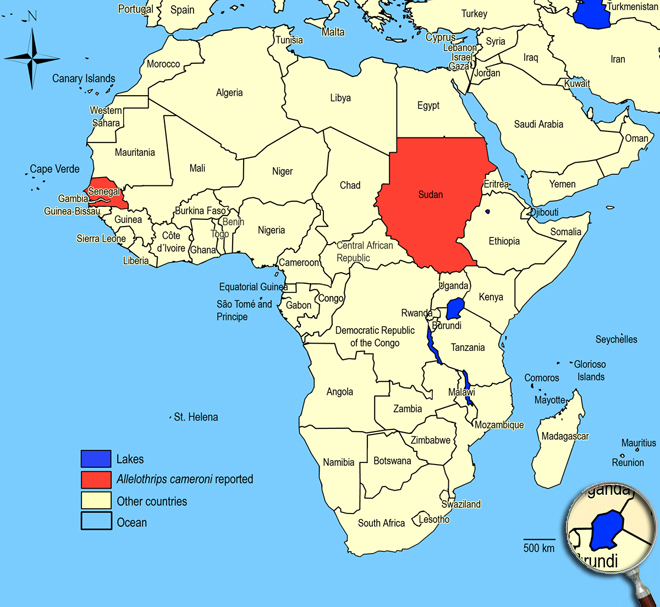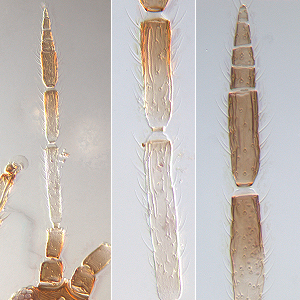Allelothrips cameroni (Bagnall, 1932)
Aeolothripidae, Terebrantia, Thysanoptera
Figures
Fig. 1: 9-segmented antenna, segments III and IV with linear sensoria, terminal segments V-IX dark in color
Fig. 2: Dark colored scape and pedicel
Fig. 3: Head dorsal with ocellar triangle
Fig. 4: Head ventral with mouth cone
Fig. 5: Pronotum
Fig. 6: Meso- and metanotum
Fig. 7: Fore wing and distal region of fore wing
Fig. 8: Meso- and metasternum
Fig. 9: Sternite VII and base of ovipositor
Fig. 10: Tergites IX-XI
Introduction and recognition
Allelothrips cameroni is a predator of other thrips observed on grasses and cereals like sorghum. Female macropterous and with a wasp-like waist. Body color light to dark grey-brown and with extensive red internal pigment. Antennae 9-segmented, elongate; segment III exceptionally long and slender, and about 5-6 times as long as wide; segments IV & V subequal in length; length of segment V subequal to VI-IX together; segments III & IV with simple linear, gently undulated sensory areas (Fig. 1 and 2). Antennal segment II distally, III, and IV basally greyish white, segments V-IX dark grey-brown (Fig. 1 and 2). Head nearly as wide as long, eyes prolonged ventrally; maxillary palpi 3-segmented (Fig. 3 and 4). Prothorax rectangular and without long setae (Fig. 5). Mesonotum minutely striate. Metanotum with a distinctive triangular area of striate sculpture, 1 pair of setae at anterior margin and 1 pair near posterior (Fig. 6). Fore tibia distally and fore tarsi paler than mid and hind legs. Tarsi 2-segmented, fore tarsus apically with stout recurved ventral hamus. Forewings with 3 dark transverse bands basally, medially, and apically (Fig. 7). Forewing slender with apex rounded, cross veins prominent; costal margin with setae but no cilia (Fig. 7). Sternites II-VII each with about 4 pairs of posteromarginal setae and 1-4 discal setae laterally (Fig. 9). Tergites with discal setae small; tergite X with pair of very small trichobothria (Fig. 10).
Male unknown.
Taxonomic identity
Species
Allelothrips cameroni (Bagnall, 1932)
Taxonomic history
Pseudaeolothrips cameroni Bagnall, 1932
Common name
-
Present taxonomic position
Family: Aeolothripidae Uzel, 1895
Genus: Allelothrips Bagnall, 1932
Genus description
The genus Allelothrips Bagnall, 1932
7 species are listed in this genus, 6 from Africa and 1 from India. The genus was defined largely on the number of maxillary palp segments, and the three nominal genera were separated on the fact that the maxillary palpi were 2-segmented (Arhipidothrips), 3-segmented (Pseudoaeolothrips) and 7- or 8-segmented (Allelothrips) (Mound 1968). Now, all of them are united to the genus Allelothrips. Members of the genus have 9-segmented antennae, the metanotum with a distinctive triangular area of striate sculpture, and the antennal sensoria are linear and simple, sometimes gently undulated, but without scalloped margins (Mound & Kibby 1998).
Species description
Typical key character states of Allelothrips cameroni
Coloration and body sculpture
Body color: mainly brown to dark brown
Antennae
Number of antennal segments: 9
Form of sensorium on antennal segment III and IV: linear (gently undulated) along the segment
Length of antennal segment III: about 5 to 6 times as long as wide
Length of antennal segment V: subequal to VI to IX together
Color of antennal segments I and II: brown, at least in part
Color of antennal segment IV: basally pale, mainly dark brown
Color of antennal segments VI-IX: brown
Wings
Fore- and hind wings: present, more than half as long as abdomen
Fore- and hind wing surface: covered with microtrichia
Fore wing surface: not reticulate
Fore wing shape: apical third about one and a half to less than twice as wide as basal third
Fringe cilia arising: from sockets
Fore wing veins: present
Number of cross veins: 2-3 (4)
Fringe cilia on posterior margin near apex: straight
Shape of fore wing apex: with continuous rounded margin
Fore wings: alternating bands of dark and light
Fore wing extreme apex color: dark
Abdomen
Ovipositor curved: upwards
Sternites IV, V and VI: with marginal setae and a few discal setae laterally
Median posterior marginal setae on sternite VII: without supernumerary setae arising in front of marginal setae
Abdominal segment 10: never tubular, longitudinally incomplete ventrally in both sexes

Similar or related species
Allelothrips cameroni differs from other species of Allelothrips in the coloration of antennal segment IV of female - pale basally and brown in distal half (Allelothrips brunneus, Allelothrips talithae and Allelothrips tenuicornis with antennal segment IV of female completely pale; Allelothrips cincticornis and Allelothrips vilardeboi with antennal segment IV completely brown to dark brown). Most of Allelothrips species have a mainly brown body color (except for Allelothrips talithae with yellow to light brown body color), fore wings with 3 dark transverse bands - basally, medially, and apically with extreme apex dark (except for Allelothrips vilardeboi with extreme apex pale), and antennal segments VI-IX have a brown to dark brown color (except for Allelothrips cincticornis with segments VI-IX pale). The species is similar to Allelothrips tenuicornis, in both species the color of antennal segments I & II is brown, at least in part (Allelothrips brunneus, Allelothrips cincticornis, Allelothrips talithae and Allelothrips vilardeboi have antennal segments I & II with pale coloration). Like Allelothrips vilardeboi, the species exhibits antennal segment III that is 5-6 times as long as wide (compared to Allelothrips cincticornis and Allelothrips talithae with antennal segment III that is 9-10 times as long as wide; Allelothrips brunneus and Allelothrips tenuicornis with antennal segment III that is 7-8 times as long as wide). Furthermore, in Allelothrips brunneus, Allelothrips cameroni, Allelothrips cincticornis and Allelothrips talithae the length of antennal segment V of female is subequal to VI-IX together (Allelothrips tenuicornis and Allelothrips vilardeboi with antennal segment V of female, that is much shorter than VI-IX together).
Species of Allelothrips differ from Franklinothrips and Aeolothrips in having a metanotum with a distinctive triangular area of striate sculpture (Aeolothrips fasciatus with metanotum median area with irregular equiangular reticulation; species of Franklinothrips lack sculpture medially). Furthermore, Franklinothrips species have antennal sensoria on segments III & IV that are linear with scalloped margins (those of Allelothrips species and Aeolothrips fasciatus are linear and simple but without scalloped margins), and 2 pairs of posteromarginal setae on sternites III-VI and 4 pairs of posteromarginal setae on sternite VII (Allelothrips species possess 4 pairs of posteromarginal setae on sternites III-VII; Aeolothrips fasciatus with 4 pairs of posteromarginal setae on sternites III-VII, and 2 pairs of supernumerary setae anterior to marginal setae S1 and S2 on sternite VII). Compared to Aeolothrips fasciatus, species of Allelothrips and Franklinothrips have discal setae laterally on sternites II-VII (Aeolothrips fasciatus without discal setae on sternites).
Biology
Life history
As with other thrips species the life cycle from egg to adult is dependent on temperature. The full cycle can take about 15 days (Lewis 1973) to over a month and adults may live for more than one month producing several generations in one year depending on seasonal weather.
Host plants
The plants on which Allelothrips cameroni are found in association with their prey are cereals and grasses like sorghum.
Vector capacity
None identified.
Damage and symptoms
-
Detection and control strategies
-
Additional notes
The species is an obligate predator and attack mainly other thrips species like larvae of Caliothrips graminicola or mites (Bagnall 1932).
Biogeography
West and East Africa, Senegal (Fete Ole),
Sudan (Wad Medani, Merebea).
African countries where Allelothrips cameroni has been reported

The species Allelothrips cameroni was not observed in surveys undertaken in East Africa on vegetables and associated weeds and crops.
Please click here for survey sites of all observed thrips species of Kenya, Tanzania and Uganda.

Bibliography
Bagnall RS (1932). Descriptions of some new genera and species of African Aeolothripoid Thysanoptera. Annals and Magazine of Natural History, Zoology, Botany and Geology. (Serie 10) 10: 287-294
Lewis T (1973). Thrips: their biology, ecology and economic importance. Academic Press Inc., London Ltd., 349 pp
Moritz G (2006). Thripse. Pflanzensaftsaugende Insekten, Bd. 1, (1. Auflage). Westarp Wissenschaften, Hohenwarsleben, 384 pp. ISBN 13: 978 3 89432 8917
Moritz G, Morris DC & Mound LA (2001). ThripsID - Pest thrips of the world. ACIAR and CSIRO Publishing Collingwood, Victoria, Australia, CDROM ISBN 1 86320 296 X
Mound LA (1968). A review of R. S. Bagnalľs Thysanoptera collections. Bulletin of the British Museum (Natural History), Entomology. Supplement 11: 1-181
Mound LA & Kibby G (1998). Thysanoptera: An identification guide, (2nd edition). CAB International, Wallingford and New York, 70 pp
Palmer JM (1990). Identification of the common thrips of Tropical Africa (Thysanoptera, Insecta). Tropical Pest Management. 36 (1): 27-49
Pitkin BR & Mound LA (1973). A catalogue of West African Thysanoptera. Bulletin de ľInstitut Fondamental ďAfrique Noire, Serie A. 35 (2): 407-449
Stannard LJ (1961). A new species of Allelothrips from South India, with notes on the synonymy and characteristics of the genus (Thysanoptera: Aeolothripidae). Bulletin of Entomology, Madras. 2: 9-11
----
Web links
Mound´s Thysanoptera pages
Thysanoptera Checklist
ICIPE Thrips survey sites
UNI Halle & Thrips sites
Thrips of California













